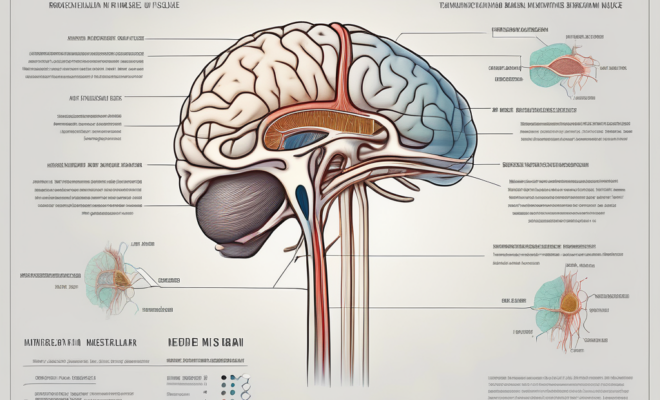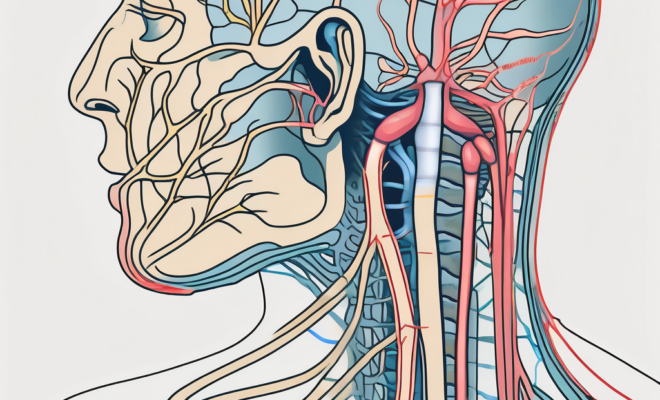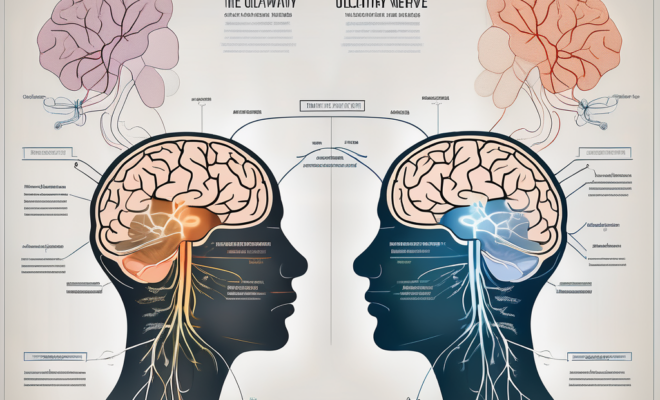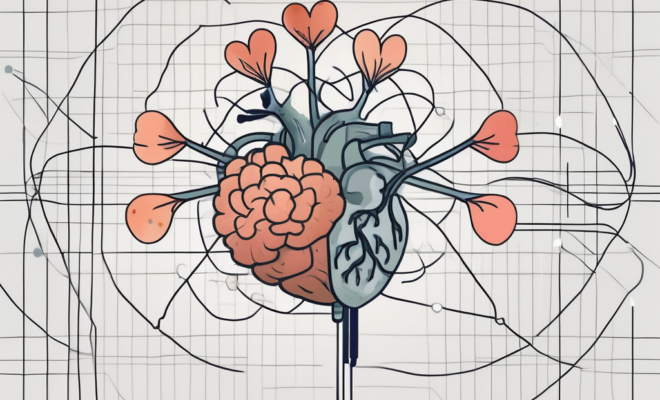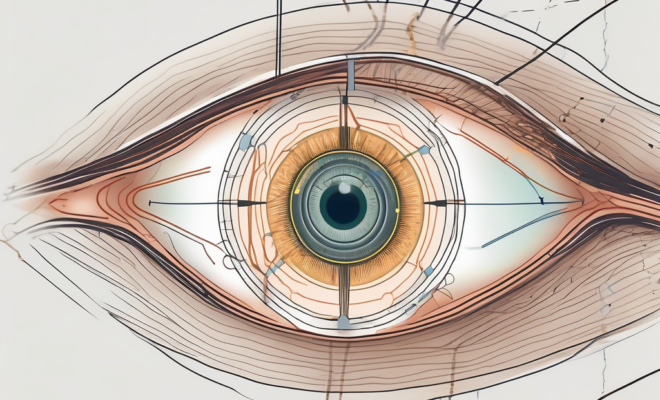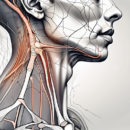The Role of the Abducens Nerve in Eye Movement

The abducens nerve, also known as cranial nerve VI, plays a crucial role in eye movement and coordination. Understanding the anatomy and function of this nerve is essential for unraveling the mysteries of ocular motility disorders and advancing our knowledge of the wider nervous system. In this article, we will explore the intricate workings of the abducens nerve, its contribution to eye movement, disorders related to its dysfunction, its interaction with other cranial nerves, and potential future research directions. Join us on this journey into the complex world of the abducens nerve.
Understanding the Abducens Nerve
At its core, the abducens nerve is responsible for the lateral movement of the eye, facilitating our ability to gaze laterally. To comprehend its role fully, we must first delve into the intricacies of its anatomy and function.
Anatomy of the Abducens Nerve
The abducens nerve arises from the pontomedullary junction in the brainstem, specifically from the abducens nucleus. It exits the brainstem through a narrow space known as the superior orbital fissure and innervates the lateral rectus muscle of the eye, which is primarily responsible for abduction, or outward movement of the eye.
But let’s not forget the fascinating journey this nerve takes. As it travels from its origin to the lateral rectus muscle, it navigates through a complex network of interconnected structures. Along its circuitous path, the abducens nerve encounters the oculomotor nucleus, the trochlear nucleus, and the medial longitudinal fasciculus, among others. This intricate interconnection ensures proper communication and coordination between the abducens nerve and other essential components of the ocular motor system.
Function of the Abducens Nerve
The primary function of the abducens nerve is to control the contraction of the lateral rectus muscle, allowing for the outward movement of the eye. It coordinates with other cranial nerves such as the oculomotor nerve to ensure smooth and precise eye movements in response to visual stimuli or voluntary commands from the brain.
But what influences the function of the abducens nerve? Well, it’s not just a simple one-way street. Several factors come into play, shaping the intricate dance of eye movements. Input from higher brain centers, such as the frontal eye fields and the parietal eye fields, provide crucial instructions to the abducens nerve, guiding its actions. Feedback from the visual system, including information from the retina and visual cortex, also influences the abducens nerve’s function. Furthermore, the abducens nerve integrates with other ocular motor nerves, such as the oculomotor and trochlear nerves, to ensure precise coordination and synchronization of eye movements.
It’s truly remarkable how all these elements work together seamlessly, allowing the abducens nerve to execute precise eye movements. This intricate interplay contributes to the harmonious functioning of the visual system as a whole, enabling us to explore the world around us with ease and precision.
The Abducens Nerve and Eye Movement
Eye movements are a remarkable feat of neurological coordination, allowing us to track objects, explore our surroundings, and perceive the world in dynamic detail. The abducens nerve plays a vital role in this intricate dance of ocular motion by contributing to both the mechanism of eye movement and lateral eye movement itself.
Mechanism of Eye Movement
The coordinated action of multiple cranial nerves, including the abducens nerve, ensures the smooth and accurate movement of our eyes. By following signals from the brain, these nerves orchestrate the precise interaction of multiple eye muscles, allowing us to track moving objects, shift our gaze, and maintain alignment.
The abducens nerve, in particular, is instrumental in initiating and regulating lateral eye movements. Its direct innervation of the lateral rectus muscle facilitates the outward movement needed for gaze fixation and tracking objects in the periphery.
The Abducens Nerve’s Contribution to Lateral Eye Movement
Lateral eye movement, also known as abduction, is a fundamental component of ocular motility. The abducens nerve, through its connection with the lateral rectus muscle, plays a pivotal role in generating this movement.
When the abducens nerve functions optimally, the lateral rectus muscle contracts, causing the eye to move laterally. This allows us to shift our focus towards objects located to the side without having to move our entire head. In coordination with other ocular motor nerves, the abducens nerve ensures precise and synchronized eye movements, enabling us to explore our environment effortlessly.
Furthermore, the abducens nerve’s involvement in lateral eye movement extends beyond simple gaze fixation. It also contributes to the coordination of eye movements during activities such as reading, driving, and playing sports. For example, when we read, our eyes move in a series of rapid, coordinated jumps called saccades. The abducens nerve, along with other cranial nerves, plays a crucial role in coordinating these saccadic eye movements, allowing us to smoothly scan the text and comprehend the words on the page.
In addition to its role in lateral eye movement coordination, the abducens nerve is also responsible for maintaining eye alignment. When the abducens nerve is functioning properly, it helps ensure that both eyes are aligned and working together to create a single, unified image. This alignment is essential for binocular vision, depth perception, and overall visual acuity.
Disorders Related to the Abducens Nerve
Like any other component of the nervous system, the abducens nerve is susceptible to dysfunction and disorders. When the abducens nerve is affected, it can result in various symptoms and complications that impact eye movement and coordination.
The abducens nerve, also known as the sixth cranial nerve, plays a crucial role in controlling the movement of the lateral rectus muscle, which is responsible for outward eye movement. When this nerve is impaired, it can lead to a condition called abducens nerve palsy. This disorder is characterized by weakened or absent lateral eye movement, causing difficulties in focusing on objects to the side.
Symptoms of Abducens Nerve Palsy
Abducens nerve palsy is a common disorder characterized by weakened or absent lateral eye movement due to impaired function of the abducens nerve. This condition often manifests through symptoms such as double vision (diplopia), difficulty in moving the affected eye laterally, and misalignment of the eyes (strabismus).
Double vision, one of the primary symptoms of abducens nerve palsy, occurs when the brain receives conflicting signals from the two eyes. This can make simple tasks such as reading or driving incredibly challenging and frustrating. Additionally, the misalignment of the eyes can lead to a lack of depth perception, making it difficult to judge distances accurately.
Patients with abducens nerve palsy may experience difficulties in daily activities such as reading, driving, and navigating crowded spaces. Prompt diagnosis and appropriate management are essential for alleviating symptoms and improving quality of life.
Treatment and Management of Abducens Nerve Disorders
The treatment and management of abducens nerve disorders often depend on the underlying cause and severity of the condition. In cases of mild palsy, conservative approaches such as patching or eye exercises to strengthen the affected eye may be employed. However, more severe or persistent cases might require surgical intervention or specialized eye muscle prisms to correct visual alignment.
Furthermore, addressing the underlying cause of the abducens nerve dysfunction is crucial for effective treatment. In some cases, abducens nerve palsy may be a result of trauma or injury to the head or eye. In such instances, a comprehensive evaluation by a healthcare professional is necessary to determine the appropriate course of action.
It is important to note that each case of abducens nerve disorder is unique, and treatment approaches should be tailored to the individual patient. Consulting with a qualified healthcare professional or specialist is crucial for accurate diagnosis, personalized treatment plans, and long-term management.
The Abducens Nerve in the Wider Nervous System
While the abducens nerve’s primary role lies in controlling eye movement, its impact extends beyond the ocular realm. Interactions with other cranial nerves and its connection to brain health add another layer of complexity to our understanding of this fascinating nerve.
The abducens nerve, also known as the sixth cranial nerve or cranial nerve VI, emerges from the pons in the brainstem. It travels through the skull, passing through the cavernous sinus, before innervating the lateral rectus muscle of the eye. This muscle is responsible for outward eye movement, allowing us to gaze laterally.
Interaction with Other Cranial Nerves
The abducens nerve collaborates with several other cranial nerves, including the oculomotor and trochlear nerves, to orchestrate the intricate dance of eye movements. This interconnected web of nerves ensures precise coordination and alignment of the visual system.
Dysfunction or disruption of any of these cranial nerves can result in a range of ocular motility disorders. Understanding the relationships between these nerves provides valuable insights into the diagnosis and treatment of conditions affecting eye movement and coordination.
The abducens nerve’s close relationship with the oculomotor nerve, responsible for controlling most of the eye’s movements, highlights the intricate coordination required for smooth and accurate eye tracking. These two nerves work together to facilitate horizontal and vertical eye movements, allowing us to scan our surroundings effectively.
The Abducens Nerve and Brain Health
Emerging research suggests that the abducens nerve’s health may be linked to broader neurological well-being. Studies have indicated possible associations between abducens nerve abnormalities and conditions such as neurodegenerative diseases, including Parkinson’s disease and Alzheimer’s disease.
Furthermore, the abducens nerve’s path through the cavernous sinus places it in proximity to crucial structures such as the internal carotid artery. This anatomical proximity underscores the potential implications of vascular issues on abducens nerve function, emphasizing the importance of holistic approaches to neurological health.
Further investigation into these connections may shed light on the early detection and treatment of neurological disorders, opening up new avenues for therapeutic interventions and management strategies.
Future Research Directions in Abducens Nerve Study
The exploration of the abducens nerve is an ever-evolving field, with numerous exciting research directions and potential advancements in store. Continued studies and technological advancements in neurology offer promising avenues for further understanding the functions and complexities of this nerve.
Technological Advancements in Neurology
The advent of innovative techniques and cutting-edge technologies, such as neuroimaging modalities and electrophysiological studies, has revolutionized our ability to explore the abducens nerve and its connections. These non-invasive tools provide invaluable insights into the structural and functional aspects of the nerve and its role in eye movement disorders.
For instance, neuroimaging modalities like functional magnetic resonance imaging (fMRI) allow researchers to map the activity of the abducens nerve in real-time, providing a dynamic view of its function. This enables scientists to identify specific regions of the brain that are involved in controlling eye movements, shedding light on the intricate neural circuitry underlying this complex process.
Advancements in genetic research, proteomics, and molecular biology have also expanded our understanding of the genetic and molecular basis of abducens nerve disorders. By unraveling the intricate genetic makeup and molecular mechanisms associated with these disorders, researchers are uncovering potential therapeutic targets and developing innovative treatment strategies.
For example, recent studies have identified specific genetic mutations that contribute to abducens nerve disorders, providing a foundation for targeted therapies. By designing interventions that specifically address these genetic abnormalities, researchers aim to restore normal function to the abducens nerve and improve eye movement control.
Potential Implications for Eye Movement Disorders
As our knowledge of the abducens nerve expands, so does the potential for developing novel treatments and interventions for eye movement disorders. Improved understanding of the underlying mechanisms and contributing factors to these disorders holds promise for developing targeted therapies that alleviate symptoms and enhance quality of life for affected individuals.
Furthermore, the insights gained from studying the abducens nerve may have broader implications for understanding and managing other ocular motility disorders. By examining the intricate interplay between the abducens nerve and other components of the oculomotor system, researchers can gain a comprehensive understanding of the mechanisms underlying various eye movement disorders.
For instance, the knowledge gained from studying the abducens nerve may shed light on disorders such as nystagmus, where involuntary eye movements disrupt visual perception. By identifying common pathways and mechanisms shared between different ocular motility disorders, researchers can develop targeted interventions that benefit a wider range of patients.
In conclusion, the future of abducens nerve research is bright, with technological advancements and a deeper understanding of the underlying mechanisms offering exciting possibilities for improved diagnosis, treatment, and management of eye movement disorders. By continuing to explore this complex nerve, researchers are paving the way for a future where individuals with impaired eye movements can enjoy a better quality of life.
Conclusion
The abducens nerve plays a vital role in eye movement, contributing to the complex symphony of ocular motility. Understanding its anatomy, function, and interactions with other cranial nerves enhances our comprehension of the broader visual system and neurological health.
Through careful examination of disorders related to the abducens nerve and ongoing research efforts, we can further elucidate the intricacies of this nerve and develop breakthroughs in diagnostic techniques, treatment strategies, and potential therapeutic interventions. By unraveling the mysteries of the abducens nerve, we unlock the potential for enhanced eye movement and a clearer vision of the intricate workings of the human nervous system.


